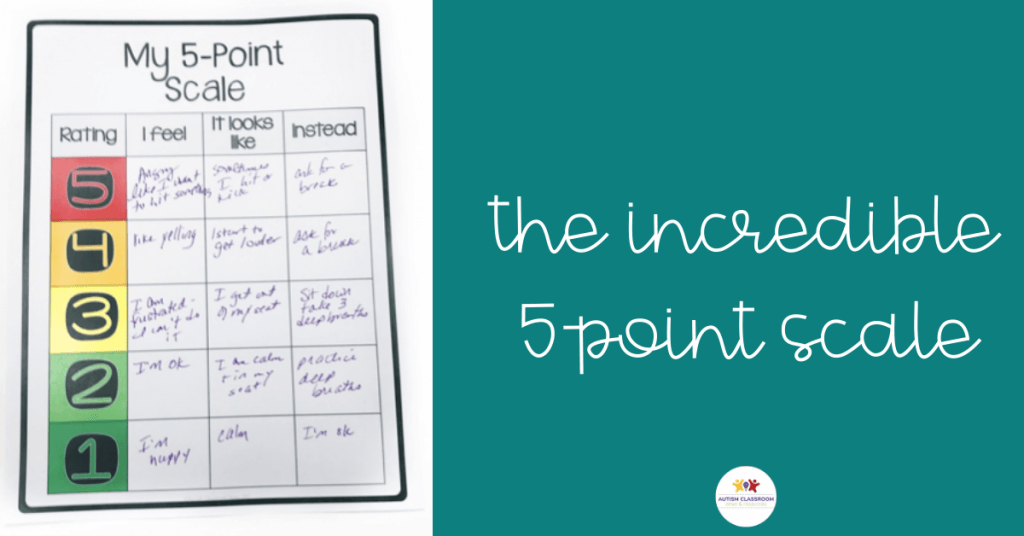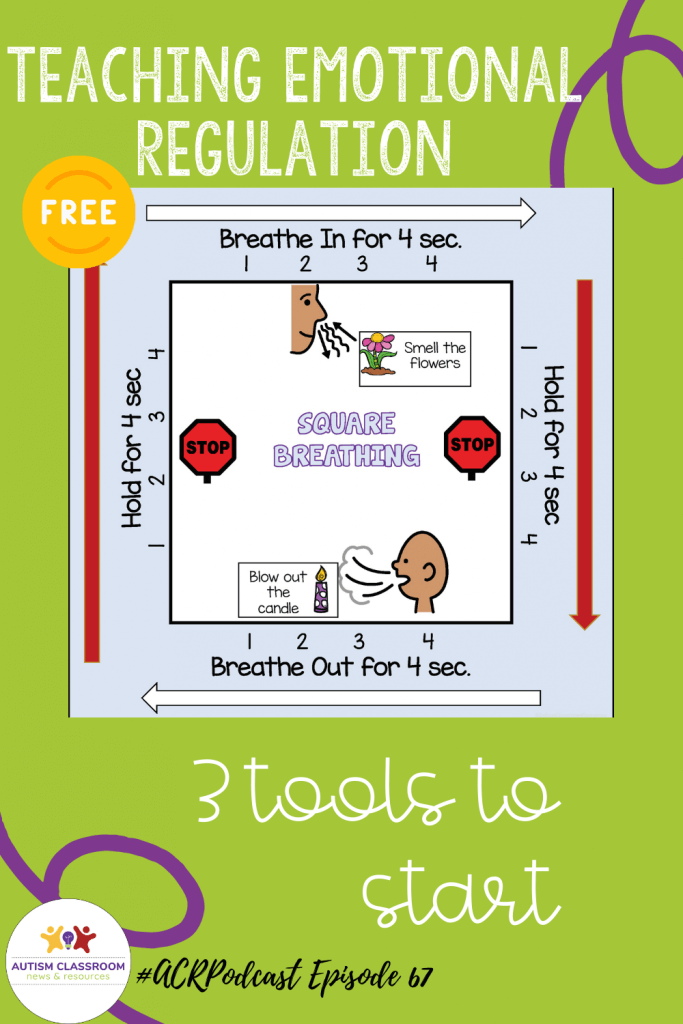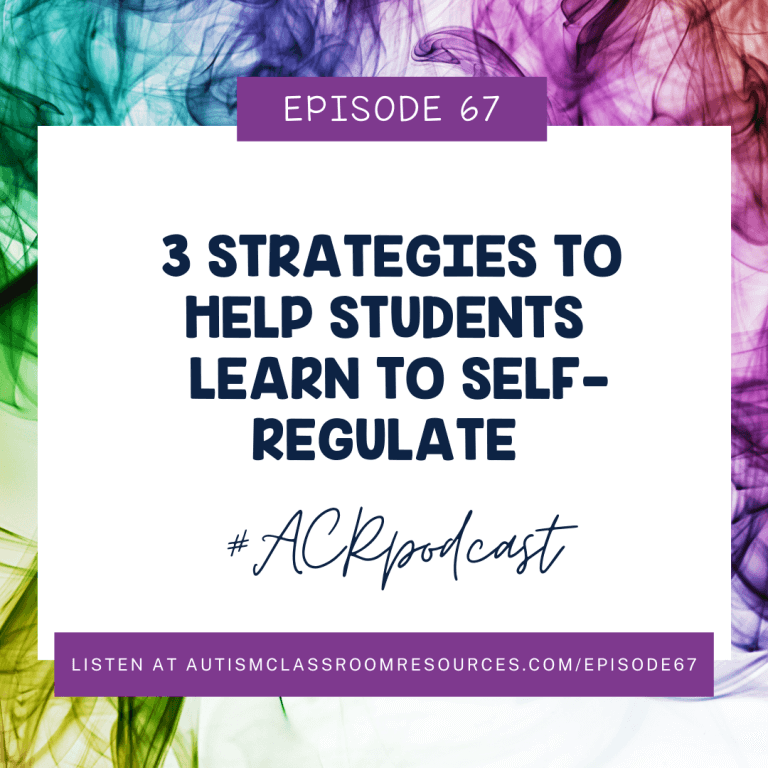In the last few episodes I talked about students with high functioning autism who often have difficulty with emotional regulation. Many of these students struggle with managing their anxiety and emotions. As I noted in episode 65, individuals with ASD are 4 times more likely to have anxiety disorders than the general population. So managing their emotions and achieving emotional regulation is key for these students. But it isn’t an easy thing for them to learn. And it isn’t an easy thing for us to teach, either.
Meet Frank: An Example of Emotional Regulation
I once was doing some mini-assessments of students for a training. And in walked this late-elementary aged student. I’ll call him Frank. Frank had an aide with him but didn’t want her in the assessment area with him. As Frank and I were working together, I was watching his body language. It was remarkably clear that he was getting more and more anxious the longer we worked. His shoulders were inching up to his ears. His face was getting screwed up with his eyes squinting at me. And he was finding it harder to answer questions.
We were just about the time that I was going to stop and take a break because I didn’t think he could take it anymore. And suddenly, Frank put his hands flat on the table. He sat up straight. He looked straight ahead and said, out loud, “Breathe!” And he took a big deep breath in and let it out slowly. And he did that 3 times. As he did that, he visibly calmed down. Then he told me he was ready to go back to work.
Needless to say, I was floored. And my first thought, having met kids like Frank before, was “Wow, I bet the teacher who taught him that never got to see him do it like that!”
A Closer Look at Frank’s Emotional Regulation
To us, Frank’s self-regulation may not look like such a big deal. But for a kid like Frank, it was huge. First, Frank learned a strategy that helped him reduce his physical anxiety and calm himself down. Taking 3 deep breaths was a pretty basic strategy of taking deep breaths. And he repeated it several times in the 25 minutes we were together. But it worked. And I’ve worked with plenty of kids that I would be thrilled if we could find one strategy that worked that well.
Second, Frank learned to recognize when he was feeling anxious. Plus Frank recognized when they reached a point that he needed to take action on them. I noted in episode 65 that recognizing internal feelings is difficult for students on the spectrum. So just that step alone is difficult for some students to learn.
Finally, he was able to take action on all of that in a new environment. Which for a student with autism was pretty impressive. Yes, maybe his stopping so suddenly was a little unusual, but it worked. So I’ll take it.
So How Do We Teach Emotional Regulation Like Frank’s?
While I can’t detail all the ins and outs of teaching emotional regulation within an episode of a podcast, I can give you pointers toward 3 strategies that you can integrate together that can get you started. So, in today’s episode I have 3 tools I want to share to help you teach your students how to self-regulate along those same 3 steps.
And I have a free download for you in the Resource Library that can help you get started with one of the strategies. And lots of helpful links in the resource links below for relaxation strategies to use with your students too.
Don’t forget if you are looking for strategies to prevent challenging behavior in your classroom, I have a free Preventing Challenging Behavior webinar that you can watch anytime. You can sign up at autismclassroomresources.com/episode67. And you can grab a transcript and the freebies there as well. Plus if you are looking for more resources to help with challenging behavior in the classroom, we have a whole course on it plus tons of resources and workshops in the Special Educator Academy. Come give us a try with a 7-day trial at specialeducatoracademy.com.
Now, let’s get started.
Kari Dunn Buron created the Incredible 5-Point Scale. It’s one of my favorite tools for teaching students to begin to understand how they are feeling. To me, the 5-point scale helps students to learn how to recognize their internal feelings and, later, to connect those feelings to actions to address them. I’ve talked about it in a blog post with more detail about why I think it’s amazing.
 Briefly, when you teach students to use the 5-Point Scale you teach them to rate how they are feeling from a 1 being calm to a 5 being highly anxious, or explosive, or full meltdown or however they describe it. And the key is how THEY describe it. You work with the student to describe how they are feeling at each point on the scale. So, they might say, “I’m feeling like a 4…I’m getting really upset. I feel like I’m going to fly apart.”
Briefly, when you teach students to use the 5-Point Scale you teach them to rate how they are feeling from a 1 being calm to a 5 being highly anxious, or explosive, or full meltdown or however they describe it. And the key is how THEY describe it. You work with the student to describe how they are feeling at each point on the scale. So, they might say, “I’m feeling like a 4…I’m getting really upset. I feel like I’m going to fly apart.”
The next piece I like about it is that when they are able to identify how they are feeling, you can start connecting it to what they can do to change that. If I’m feeling like a 4, I can identify strategies I can do to bring that number down. So, next to the 4, I might identify taking deep breaths, playing basketball, or removing myself from a situation as strategies to calm down. I can directly relate the strategy to how I’m feeling. And I can identify specifically that when I start to feel like a 3 or a 4, I should start taking action for emotional regulation.
So our next step in emotional regulation is knowing how to regulate. So for Frank, it was taking those 3 deep breaths. The hard part with taking deep breaths for many students on the spectrum is that they don’t know how that feels. And many I’ve met end up almost hyperventilating because they breathe too fast.
Visuals can help with that. Learning to breathe in and out is a good way to regulate breathing. Regulating breathing is a great way to reduce anxiety, in particular. One that I particularly like is the art of Square Breathing. Square breathing is when you breathe in for a count of 4, hold for a count of 4. Breathe out for a count of 4. Hold for a count of 4. And the visual is essentially following those 4 actions around a square.
One of the things I like about square breathing is that it focuses the student on the graphic and on the process. It’s more than just take 3 deep breaths. It’s specific about how you do it. I like it because it can also useful because they can practice breathing by smelling the flowers (breathing in by their nose) and blowing out the candles (out through their mouth).
Square Breathing Freebie
And to help them (and you) I’ve got a free square breathing graphic you can download in the free resource library in the post for this episode. You can hop over to the episode at autismclassroomresources.com/episode67 and grab it there. P.S. it comes in handy sometimes for staff at IEP meetings too!
Now there are tons of ways and strategies for self-regulation and deep breathing is only one of them. Progressive relaxation is another and I’ve talked about that in a post I’ll put in the resource links. I also have a kit of self-calming visuals that you can find in my stores that I’ll link to with calming visuals. But square breathing is often a simple, easy way to start.
If you’ve implemented and taught tools 1 and 2, you’ve taught your student to identify when they feel upset or anxious. And you have taught them what to do when they start to escalate in those feelings to reduce them. Next up is starting to really implement those strategies throughout the day.
Let’s face it, we all have emotional regulation strategies we use that sometimes fail in the real world. Everything is going great until it’s not. And that’s when we really need our strategies to kick in. But if the strategies are new…that is probably when they aren’t likely to be automatic.
To get to more regular use of regulation strategies, students have to practice. But they also need regular reminders, guidance, and check-ins. And that’s where Check-In Check-Out (CICO) comes in. CICO is a research-based strategy used as part of a Tier 2 positive behavioral support. It is designed to be used with an adult or set of adults that the student trusts to meet with before and after class or before and after school. I’ve typically found it useful to have regular checkins throughout the day for most students.
How CICO Works
The student and the adult(s) establish behavioral goals to be met. So, in Frank’s case, it might be staying calm in unfamiliar situation. Taking 3 deep breaths when needed. If Frank was using the 5-Point Scale it could be Keeping my emotions at a 3 or lower on my 5-Point Scale. Typically there is a reinforcer for meeting the behavioral goal at the end of the time set that is administered by the adult. And there is a behavior report card or some type of points sheet that is used to track the behavior over time. That report card also goes home to the parents to communicate progress to them about behavior as well. For a more detailed summary, I’ll include a tip sheet link with some references in the post.
One of the byproducts of CICO for students with anxiety is the opportunity to talk about what worked and what didn’t about the systems. And to problem solve when something didn’t work to make changes to the strategies to account for unforeseen stressors or situations.
Summary
As I said I could spend days talking about emotional regulation. And in fact when I talk about behavioral support for students with high functioning autism in training, I do spend a whole day effectively talking about just this topic. But these are 3 strategies that when used together can at least give you a starting point or things to try.
Don’t forget to go grab your free square breathing visual from the resource library at the blog post. And you can get a transcript and links for more info at autismclassroomresources.com/episode67. You can also get the link to sign up for the free webinar on preventing challenging behavior there as well.
I will be taking next week off, but will likely have a post up on the blog instead of a podcast. But I will be back in 2 weeks with a new podcast episode, so be on the lookout for that. If you are working with students who struggle with emotional regulation and have strategies you use for it, I’d love to hear more about it. Hop over to our free Facebook group at specialeducatorsconnection.com and answer the 3 questions and share with them with us.
Thank you as always for everything you do for your students and for joining us today. I hope to see you again in 2 weeks and on the blog next week!





 Briefly, when you teach students to use the 5-Point Scale you teach them to rate how they are feeling from a 1 being calm to a 5 being highly anxious, or explosive, or full meltdown or however they describe it. And the key is how THEY describe it. You work with the student to describe how they are feeling at each point on the scale. So, they might say, “I’m feeling like a 4…I’m getting really upset. I feel like I’m going to fly apart.”
Briefly, when you teach students to use the 5-Point Scale you teach them to rate how they are feeling from a 1 being calm to a 5 being highly anxious, or explosive, or full meltdown or however they describe it. And the key is how THEY describe it. You work with the student to describe how they are feeling at each point on the scale. So, they might say, “I’m feeling like a 4…I’m getting really upset. I feel like I’m going to fly apart.”


